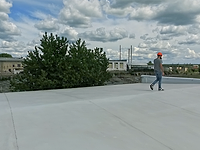New Cellulose Nanotechnology

The material is composed of cellulose, organized into a unique physical form that imparts properties that are different from other types of cellulose. The material has many of the characteristics of a nanomaterial but without the presence of free nanofibers. The company’s philosophy is to find alternative sources of raw materials from the standard petrochemical base that is currently used and to process these green materials by high-tech but low-energy methods, creating innovative new additives that will be high performance and cost effective.
How Curran® is Different
Curran® has a number of unique properties.
• The nanofibers that make up the material have very high mechanical properties, with strength similar to carbon fiber (Figure 1).
• The physical form of the material means that there is a huge surface area for interaction with water and or polymers, and the shape of the particles imparts unique viscosity profiles and crack-stopping capabilities.
• The chemistry of the material results in a large number of available OH groups. These can be used to interact with a wide range of materials, or they can be chemically modified to enable specific reactions (forming covalent bonds) with polymers such as epoxies and acrylics.
Because of Curran’s® huge potential versatility, Cellu-Comp has developed a number of different versions of the material, designed or optimized to perform different functions in paint formulations.
These are:
1. A rheology modifier designed to give very efficient thickening with strong shear thinning characteristics.
2. A multifunctional material that provides opportunities for enhanced reinforcement/toughening of both curing and cured films, while providing good rheology.
3. A material designed to give enhanced mechanical properties. These materials are available as either a particulate or a slurry. They contain a biocide to give good shelf life and have been designed to easily disperse in water-based paint formulations. The particulate is in the form of small granules that still contain some water and, therefore, is not dusty when handled.
Benefits to Paint Formulating
The Curran® particles have very good reinforcement capabilities, and because of the crystalline nature of the cellulose they can increase the hardness of polymer systems. CelluComp has found that additions of only 1-5% on a solids basis of Curran® to a water-based polymer can impart the following properties (depending upon the other paint ingredients):
• Reduction in mud cracking during drying of a water-based paint under non-optimal conditions, e.g., when the paint is applied too thickly to the substrate;
• Increased hardness;
• Reduction in solvent (e.g., coalescent in water-based acrylics) without cracking problems during drying and curing.
For example, when 1.5% by solids of Curran® was mixed into a clearcoat acrylic paint, the coalescent content could be reduced by approximately 10% without causing cracking problems during drying. Without the Curran® this reduction in coalescent resulted in significant cracking of the drying film (Figure 2). In the same formulation the hardness of the cured film was increased by 90% as measured using a pendulum hardness tester (Table 1).
As mentioned earlier, a Curran® formulation with extremely effective rheological properties has also been developed. This material has exhibited thickening efficiency greater than other cellulose thickeners and in fact other thickeners in general. Also the viscosity vs. rate profile shows extreme shear thinning. This means that the material has proved to be very good at providing sag resistance and is an effective anti-settling agent. Additionally, when used to thicken water-based epoxy formulations, Curran® is just as effective in the absence of an associative thickener (Figure 3).
Conclusion
When the multifunctionality of the material is considered, CelluComp proposes that in addition to enhanced performance, cost savings on overall formulation may be achieved by replacing several additives with the new Curran® material.
For more information, visit www.cellucomp.com, or e-mail Christian Kemp-Griffin at ckgriffin@cellucomp.com or Dr. David Hepworth at david.hepworth@cellucomp.com.
Looking for a reprint of this article?
From high-res PDFs to custom plaques, order your copy today!









